Trends in Renewable Electricity Generation in the G20 Countries: An Analysis of the 1990–2020 Period
Abstract
:1. Introduction
2. Literature Review
3. Methods and Data
- Xt—percent participation of the type of electricity in the total production of the electricity matrix of the country for the period t;
- ESt (Electricity Supply)—amount of production of each type of electricity in the country in period t, (GWh);
- GESt (General Electricity Supply)—total amount of electricity produced in the country for the period t (GWh).
4. Analysis and Discussion
4.1. Analysis and Discussion of G20 Contributions to Renewable Electricity Generation
4.2. Population, GPD, and CO2 Emissions
5. Conclusions
Author Contributions
Funding
Institutional Review Board Statement
Informed Consent Statement
Data Availability Statement
Conflicts of Interest
References
- Raugei, M.; Peluso, A.; Leccisi, E.; Fthenakis, V. Life-Cycle Carbon Emissions and Energy Return on Investment for 80% Domestic Renewable Electricity with Battery Storage in California (USA). Energies 2020, 13, 3934. [Google Scholar] [CrossRef]
- Bilgili, F.; Lorente, D.B.; Kuşkaya, S.; Ünlü, F.; Gençoğlu, P.; Rosha, P. The role of hydropower energy in the level of CO2 emissions: An application of continuous wavelet transform. Renew. Energy 2021, 178, 283–294. [Google Scholar] [CrossRef]
- Röder, J.; Beier, D.; Meyer, B.; Nettelstroth, J.; Stührmann, T.; Zondervan, E. Design of Renewable and System-Beneficial District Heating Systems Using a Dynamic Emission Factor for Grid-Sourced Electricity. Energies 2020, 13, 619. [Google Scholar] [CrossRef] [Green Version]
- Acaravci, A.; Ozturk, I. Electricity consumption-growth nexus: Evidence from panel data for transition countries. Energy Econ. 2010, 32, 604–608. [Google Scholar] [CrossRef]
- IEA. International Energy Agency. In International Energy Outlook 2017; OECD Publishing: Paris, France, 2017. [Google Scholar]
- Barros, M.V.; da Silva, B.P.A.; Piekarski, C.M.; da Luz, L.M.; Yoshino, R.T.; Tesser, D.P. Carbon footprint of transportation habits in a Brazilian university. Environ. Qual. Manag. 2018, 28, 139–148. [Google Scholar] [CrossRef]
- UNFCCC (United Nations Framework Convention on Climate Change). End of Coal in Sight at COP26. Available online: https://unfccc.int/news/end-of-coal-in-sight-at-cop26 (accessed on 27 November 2021).
- UNFCCC (United Nations Framework Convention on Climate Change). The Paris Agreement. 2021. Available online: https://unfccc.int/process-and-meetings/the-paris-agreement/the-paris-agreement (accessed on 27 November 2021).
- Salvador, R.; Barros, M.V.; Rosário, J.G.D.P.D.; Piekarski, C.M.; da Luz, L.M.; de Francisco, A.C. Life cycle assessment of electricity from biogas: A systematic literature review. Environ. Prog. Sustain. Energy 2019, 38, 13133. [Google Scholar] [CrossRef]
- Fraunholz, C.; Keles, D.; Fichtner, W. On the role of electricity storage in capacity remuneration mechanisms. Energy Policy 2021, 149, 112014. [Google Scholar] [CrossRef]
- Middelhoff, E.; Madden, B.; Ximenes, F.; Carney, C.; Florin, N. Assessing electricity generation potential and identifying possible locations for siting hybrid concentrated solar biomass (HCSB) plants in New South Wales (NSW), Australia. Appl. Energy 2022, 305, 117942. [Google Scholar] [CrossRef]
- Qiao, H.; Zheng, F.; Jiang, H.; Dong, K. The greenhouse effect of the agriculture-economic growth-renewable energy nexus: Evidence from G20 countries. Sci. Total Environ. 2019, 671, 722–731. [Google Scholar] [CrossRef]
- Zeraibi, A.; Balsalobre-Lorente, D.; Murshed, M. The influences of renewable electricity generation, technological innovation, financial development, and economic growth on ecological footprints in ASEAN-5 countries. Environ. Sci. Pollut. Res. 2021, 28, 51003–51021. [Google Scholar] [CrossRef]
- Barthelmie, R.J.; Pryor, S.C. Climate Change Mitigation Potential of Wind Energy. Climate 2021, 9, 136. [Google Scholar] [CrossRef]
- Cui, Y.; Zhu, J.; Zoras, S.; Qiao, Y.; Zhang, X. Energy performance and life cycle cost assessments of a photovoltaic/thermal assisted heat pump system. Energy 2020, 206, 118108. [Google Scholar] [CrossRef]
- Azam, A.; Rafiq, M.; Shafique, M.; Yuan, J. Renewable electricity generation and economic growth nexus in developing countries: An ARDL approach. Econ. Res. Ekon. Istraživanja 2021, 34, 2423–2446. [Google Scholar] [CrossRef]
- Herrando, M.; Markides, C.N.; Hellgardt, K. A UK-based assessment of hybrid PV and solar-thermal systems for domestic heating and power: System performance. Appl. Energy 2014, 122, 288–309. [Google Scholar] [CrossRef] [Green Version]
- Brodny, J.; Tutak, M.; Bindzár, P. Assessing the Level of Renewable Energy Development in the European Union Member States. A 10-Year Perspective. Energies 2021, 14, 3765. [Google Scholar] [CrossRef]
- Langsdorf, S. EU Energy Policy: From the ECSC to the Energy Roadmap 2050. Brussels: Green European Foundation. Available online: http://archive.gef.eu/uploads/uploads/media/History_of_EU_energy_policy.pdf (accessed on 25 November 2021).
- UNFCCC, U.N. Kyoto Protocol Reference Manual on Accounting of Emissions and Assigned Amount. 2008. Available online: https://unfccc.int/sites/default/files/08_unfccc_kp_ref_manual.pdf (accessed on 27 November 2021).
- Martin, J.W.; Croukamp, L. Exploration into the potential for a low-enthalpy geothermal power plant in Cape fold belt. Geothermics 2021, 89, 101934. [Google Scholar] [CrossRef]
- Matuszewska-Janica, A.; Żebrowska-Suchodolska, D.; Ala-Karvia, U.; Hozer-Koćmiel, M. Changes in Electricity Production from Renewable Energy Sources in the European Union Countries in 2005–2019. Energies 2021, 14, 6276. [Google Scholar] [CrossRef]
- Brodny, J.; Tutak, M. Analysis of the efficiency and structure of energy consumption in the industrial sector in the European Union countries between 1995 and 2019. Sci. Total Environ. 2022, 808, 152052. [Google Scholar] [CrossRef]
- European Union. Directive 2009/28/EC of the European Parliament and of the Council of 23 April 2009 on the Promotion of the Use of Energy from Renewable Sources and Amending and Subsequently Repealing Directives 2001/77/EC and 2003/30/EC. Available online: https://eur-lex.europa.eu/LexUriServ/LexUriServ.do?uri=OJ:L:2009:140:0016:0062:en:PDF (accessed on 25 November 2021).
- Bartolini, A.; Carducci, F.; Muñoz, C.B.; Comodi, G. Energy storage and multi energy systems in local energy communities with high renewable energy penetration. Renew. Energy 2020, 159, 595–609. [Google Scholar] [CrossRef]
- European Commission. Energy Roadmap 2050. Available online: https://ec.europa.eu/energy/sites/ener/files/documents/2012_energy_roadmap_2050_en_0.pdf (accessed on 25 November 2021).
- Yang, S.; Park, S. The effects of renewable energy financial incentive policy and democratic governance on renewable energy aid effectiveness. Energy Policy 2020, 145, 111682. [Google Scholar] [CrossRef]
- Huterski, R.; Huterska, A.; Zdunek-Rosa, E.; Voss, G. Evaluation of the Level of Electricity Generation from Renewable Energy Sources in European Union Countries. Energies 2021, 14, 8150. [Google Scholar] [CrossRef]
- IEA (International Energy Agency). Energy Technology Perspectives 2015: Mobilising Innovation to Accelerate Climate Action. Available online: https://doi.org/10.1787/energy_tech-2015-en (accessed on 25 November 2021).
- Bilgili, M.; Yildirim, A.; Ozbek, A.; Celebi, K.; Ekinci, F. Long short-term memory (LSTM) neural network and adaptive neuro-fuzzy inference system (ANFIS) approach in modeling renewable electricity generation forecasting. Int. J. Green Energy 2021, 18, 578–594. [Google Scholar] [CrossRef]
- Medeiros, S.E.L.; Nilo, P.F.; Silva, L.P.; Santos, C.A.C.; Carvalho, M.; Abrahao, R. Influence of climatic variability on the electricity generation potential by renewable sources in the Brazilian semi-arid region. J. Arid Environ. 2021, 184, 104331. [Google Scholar] [CrossRef]
- Okada, M.; Onishi, T.; Obara, S.Y. A design algorithm for an electric power system using wide-area interconnection of renewable energy. Energy 2020, 193, 116638. [Google Scholar] [CrossRef]
- Strazzabosco, A.; Kenway, S.J.; Lant, P.A. Quantification of renewable electricity generation in the Australian water industry. J. Clean. Prod. 2020, 254, 120119. [Google Scholar] [CrossRef] [Green Version]
- Khan, I.; Kabir, Z. Waste-to-energy generation technologies and the developing economies: A multi-criteria analysis for sustainability assessment. Renew. Energy 2020, 150, 320–333. [Google Scholar] [CrossRef]
- Joshi, S.; Mittal, S.; Holloway, P.; Shukla, P.R.; Ó Gallachóir, B.; Glynn, J. High resolution global spatiotemporal assessment of rooftop solar photovoltaics potential for renewable electricity generation. Nat. Commun. 2021, 12, 1–15. [Google Scholar] [CrossRef] [PubMed]
- Yu, B.; Fang, D.; Yu, H.; Zhao, C. Temporal-spatial determinants of renewable energy penetration in electricity production: Evidence from EU countries. Renew. Energy 2021, 180, 438–451. [Google Scholar] [CrossRef]
- GWEC (Global Wind Energy Council). Global Wind Report 2021. Available online: https://gwec.net/global-wind-report-2021/ (accessed on 29 November 2021).
- Shah, M.I.; Kirikkaleli, D.; Adedoyin, F.F. Regime switching effect of COVID-19 pandemic on renewable electricity generation in Denmark. Renew. Energy 2021, 175, 797–806. [Google Scholar] [CrossRef]
- Koecklin, M.T.; Longoria, G.; Fitiwi, D.Z.; DeCarolis, J.F.; Curtis, J. Public acceptance of renewable electricity generation and transmission network developments: Insights from Ireland. Energy Policy 2021, 151, 112185. [Google Scholar] [CrossRef]
- Boudet, H.; Zanocco, C.; Stelmach, G.; Muttaqee, M.; Flora, J. Public preferences for five electricity grid decarbonization policies in California. Rev. Policy Res. 2021, 38, 510–528. [Google Scholar] [CrossRef]
- McCallum, C.S.; Kumar, N.; Curry, R.; McBride, K.; Doran, J. Renewable electricity generation for off grid remote communities; Life Cycle Assessment Study in Alaska, USA. Appl. Energy 2021, 299, 117325. [Google Scholar] [CrossRef]
- G20. About the G20. 2021. Available online: https://g20.org/about-the-g20/ (accessed on 27 November 2021).
- IEA (International Energy Agency). Data and Statistics. 2021. Available online: https://www.iea.org/data-and-statistics/data-browser?country=WORLD&fuel=Energy%20supply&indicator=TESbySource (accessed on 27 November 2021).
- UN (United Nations). Department of Economic and Social Affairs: Population Dynamics. 2021. Available online: https://population.un.org/wpp/Download/Standard/Population/ (accessed on 27 November 2021).
- EU—European Union. Country Profiles. 2021. Available online: https://europa.eu/european-union/about-eu/countries_pt#tab-0-1 (accessed on 5 December 2021).
- The World Bank. Data. 2022. Available online: https://data.worldbank.org/indicator/NY.GDP.MKTP.CD?view=chart (accessed on 11 January 2022).
- IPCC (Intergovernmental Panel on Climate Change). Impacts 2021, Adaptation, and Vulnerability. In Contribution of Working Group II to the Fifth Assessment Report of the Intergovernmental Panel on Climate Change; Cambridge University Press: Cambridge, UK, 2014. [Google Scholar]
- Abrahao, R.; Peixoto, I.M.B.M.; Carvalho, M. Solar or wind energy for the Brazilian semiarid? Climatic characterization and future trends. In Proceedings of the 30th International Conference on Efficiency 2017, Cost, Optimization, Simulation and Environmental Impact of Energy Systems, San Diego, CA, USA, 2–6 July 2017. [Google Scholar]
- Melo, F.M.; Silvestre, A.; Carvalho, M. Carbon footprints associated with electricity generation from biomass syngas and diesel. Environ. Eng. Manag. J. (EEMJ) 2019, 18, 1391–1397. [Google Scholar]
- Rosa, C.B.; Wendt, J.F.M.; Chaves, D.M.; Thomasi, V.; Michels, L.; Siluk, J.C.M. Mathematical modeling for the measurement of the competitiveness index of Brazil south urban sectors for installation of photovoltaic systems. Energy Policy 2020, 136, 111048. [Google Scholar] [CrossRef]
- Saidi, K.; Omri, A. Reducing CO2 emissions in OECD countries: Do renewable and nuclear energy matter? Prog. Nucl. Energy 2020, 126, 103425. [Google Scholar] [CrossRef]
- Bórawski, P.; Bełdycka-Bórawska, A.; Szymańska, E.J.; Jankowski, K.J.; Dubis, B.; Dunn, J.W. Development of renewable energy sources market and biofuels in The European Union. J. Clean. Prod. 2019, 228, 467–484. [Google Scholar] [CrossRef]
- Sahin, U. Projections of Turkey’s electricity generation and installed capacity from total renewable and hydro energy using fractional nonlinear grey Bernoulli model and its reduced forms. Sustain. Prod. Consum. 2020, 23, 52–62. [Google Scholar] [CrossRef]
- Luo, T.; Young, R.; Reig, P. Aqueduct Projected Water Stress Country Rankings. Tech. Note 2015, 16. Available online: https://www.wri.org/research/aqueduct-projected-water-stress-country-rankings (accessed on 29 November 2021).
- Kumar, S.; Loosen, M.; Madlener, R. Assessing the potential of low-carbon technologies in the German energy system. J. Environ. Manag. 2020, 262, 110345. [Google Scholar] [CrossRef]
- Jafari, M.; Bompard, E.; Delmastro, C.; Botterud, A.; Grosso, D. Electrify Italy: The role of renewable energy. Gas 2022, 2030, 2050. [Google Scholar]
- Villamor, L.V.; Avagyan, V.; Chalmers, H. Opportunities for reducing curtailment of wind energy in the future electricity systems: Insights from modelling analysis of Great Britain. Energy 2020, 195, 116777. [Google Scholar] [CrossRef]
- Xiaosan, Z.; Qingquan, J.; Iqbal, K.S.; Manzoor, A.; Ur, R.Z. Achieving sustainability and energy efficiency goals: Assessing the impact of hydroelectric and renewable electricity generation on carbon dioxide emission in China. Energy Policy 2021, 155, 112332. [Google Scholar] [CrossRef]
- Murshed, M.; Rashid, S.; Ulucak, R.; Dagar, V.; Rehman, A.; Alvarado, R.; Nathaniel, S.P. Mitigating energy production-based carbon dioxide emissions in Argentina: The roles of renewable energy and economic globalization. Environ. Sci. Pollut. Res. 2021, 1–20. [Google Scholar] [CrossRef] [PubMed]
- Sebi, C.; Vernay, A.L. Community renewable energy in France: The state of development and the way forward. Energy Policy 2020, 147, 111874. [Google Scholar] [CrossRef]
- Strazzabosco, A.; Kenway, S.J.; Conrad, S.A.; Lant, P.A. Renewable electricity generation in the Australian water industry: Lessons learned and challenges for the future. Renew. Sustain. Energy Rev. 2021, 147, 111236. [Google Scholar] [CrossRef]
- Russian Federation. Decree No. 449 on the Mechanism for the Promotion of Renewable Energy on the Wholesale Electricity and Market; Ministry of Energy of the Russian Federation: Moscow, Russia, 2013. [Google Scholar]
- Pablo-Romero, M.P.; Sánchez-Braza, A.; Galyan, A. Renewable energy use for electricity generation in transition economies: Evolution, targets and promotion policies. Renew. Sustain. Energy Rev. 2021, 138, 110481. [Google Scholar] [CrossRef]
- Zhu, D.; Mortazavi, S.M.; Maleki, A.; Aslani, A.; Yousefi, H. Analysis of the robustness of energy supply in Japan: Role of renewable energy. Energy Rep. 2020, 6, 378–391. [Google Scholar] [CrossRef]
- Lee, J.M.; Howard, G. The impact of technical efficiency, innovation, and climate policy on the economic viability of renewable electricity generation. Energy Econ. 2021, 100, 105357. [Google Scholar] [CrossRef]
- Ramesh, M.; Saini, R.P. Dispatch strategies based performance analysis of a hybrid renewable energy system for a remote rural area in India. J. Clean. Prod. 2020, 259, 120697. [Google Scholar] [CrossRef]
- Pillai, I.R.; Banerjee, R. Renewable energy in India: Status and potential. Energy 2009, 34, 970–980. [Google Scholar] [CrossRef]
- Erdiwansyah, E.; Mahidin, M.; Husin, H.; Nasaruddin, N.; Khairil, K.; Zaki, M.; Jalaluddin, J. Investigation of availability, demand, targets, and development of renewable energy in 2017–2050: A case study in Indonesia. Int. J. Coal Sci. Technol. 2021, 8, 483–499. [Google Scholar] [CrossRef]
- Kurniawan, T.A.; Liang, X.; Singh, D.; Othman, M.H.D.; Goh, H.H.; Gikas, P.; Shoqeir, J.A. Harnessing landfill gas (LFG) for electricity: A strategy to mitigate greenhouse gas (GHG) emissions in Jakarta (Indonesia). J. Environ. Manag. 2022, 301, 113882. [Google Scholar] [CrossRef] [PubMed]
- Dhina, N.; Permana, T. Natural Gas Transportation Business Contribution to Indonesia’s National Energy Policy and Carbon Emission Offset by on-Grid Solar PV Utilization: Surabaya, East Java, Indonesia. IOP Conf. Ser. Earth Environ. Sci. 2021, 753, 012022. [Google Scholar] [CrossRef]
- Lee, C.Y.; Huh, S.Y. Forecasting the diffusion of renewable electricity considering the impact of policy and oil prices: The case of South Korea. Appl. Energy 2017, 197, 29–39. [Google Scholar] [CrossRef]
- Nam, H. Impact of nuclear phase-out policy and energy balance in 2029 based on the 8th Basic Plan for long-term electricity supply and demand in South Korea. Renew. Sustain. Energy Rev. 2020, 122, 109723. [Google Scholar] [CrossRef]
- Alshehry, A.S.; Belloumi, M. Energy consumption, carbon dioxide emissions and economic growth: The case of Saudi Arabia. Renew. Sustain. Energy Rev. 2015, 41, 237–247. [Google Scholar] [CrossRef]
- Mosly, I.; Makki, A.A. Current status and willingness to adopt renewable energy technologies in Saudi Arabia. Sustainability 2018, 10, 4269. [Google Scholar] [CrossRef] [Green Version]

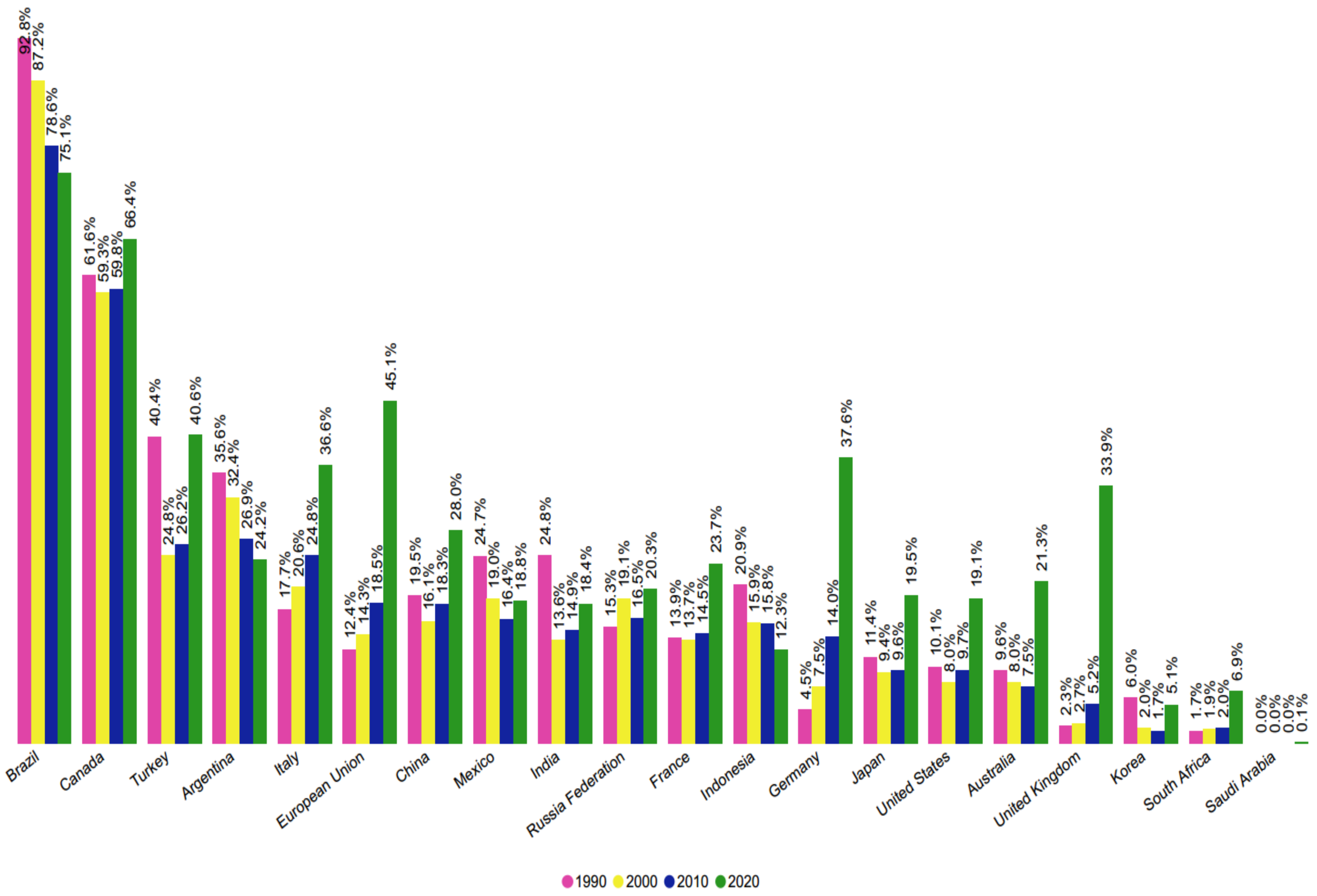
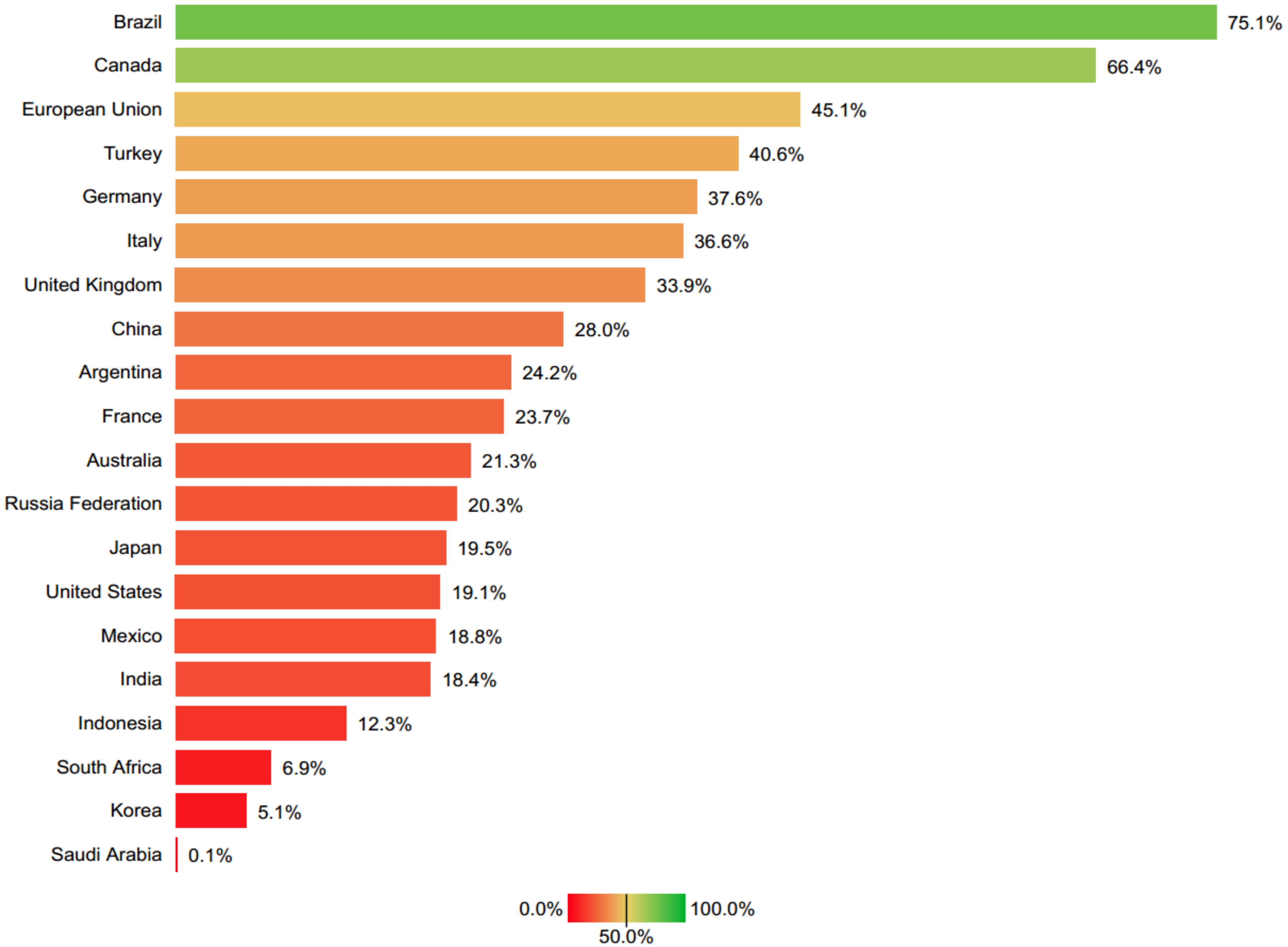
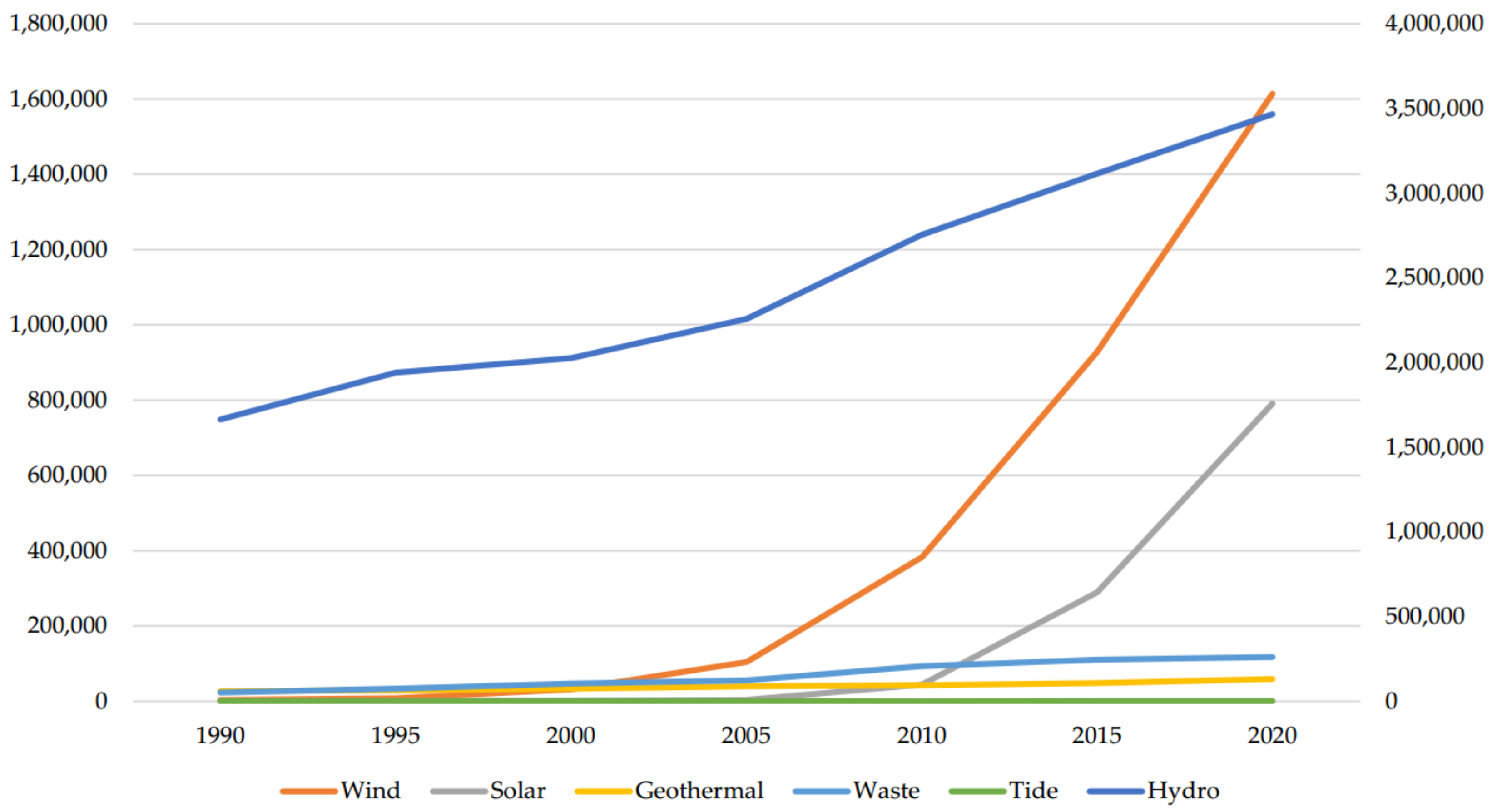
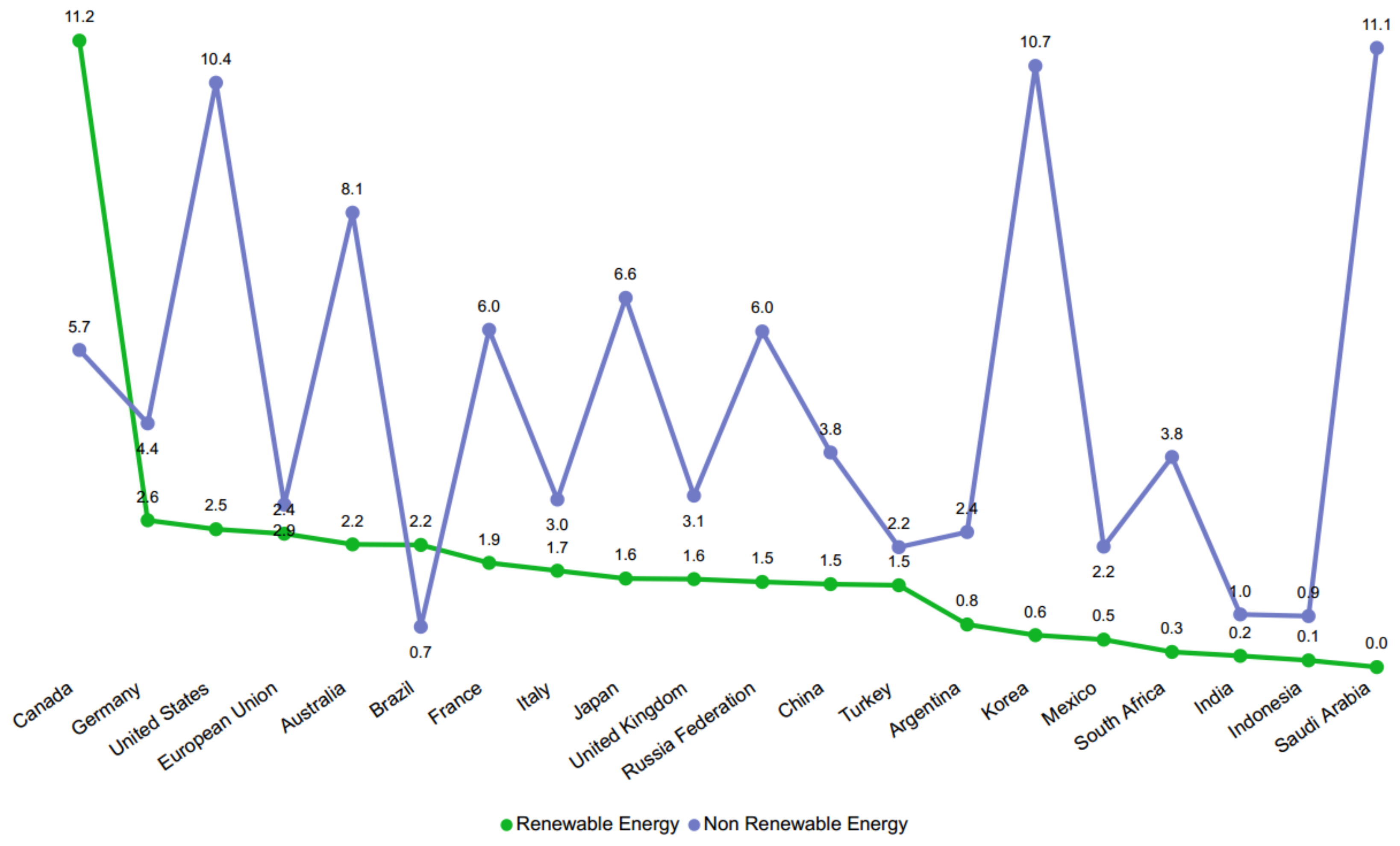
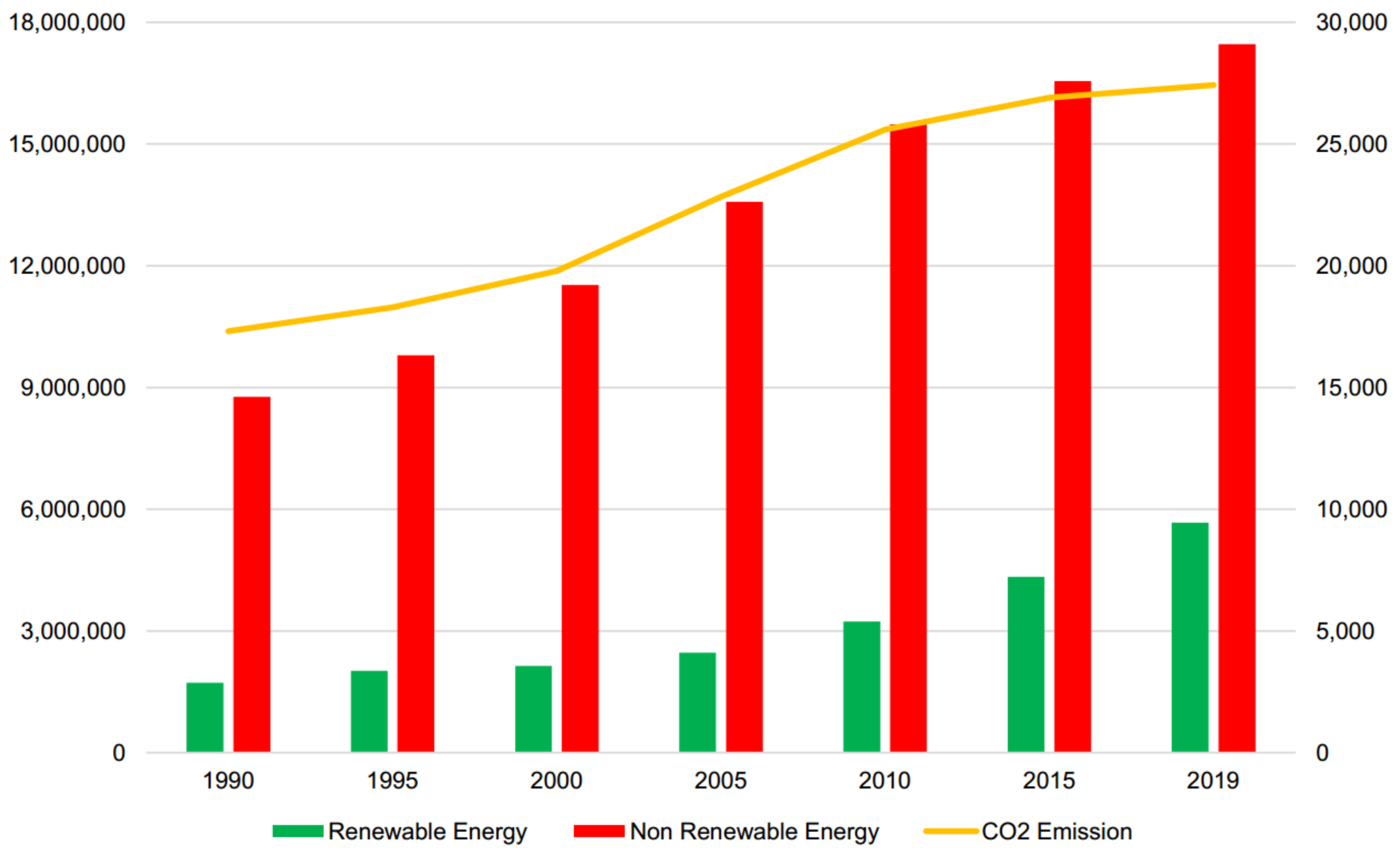
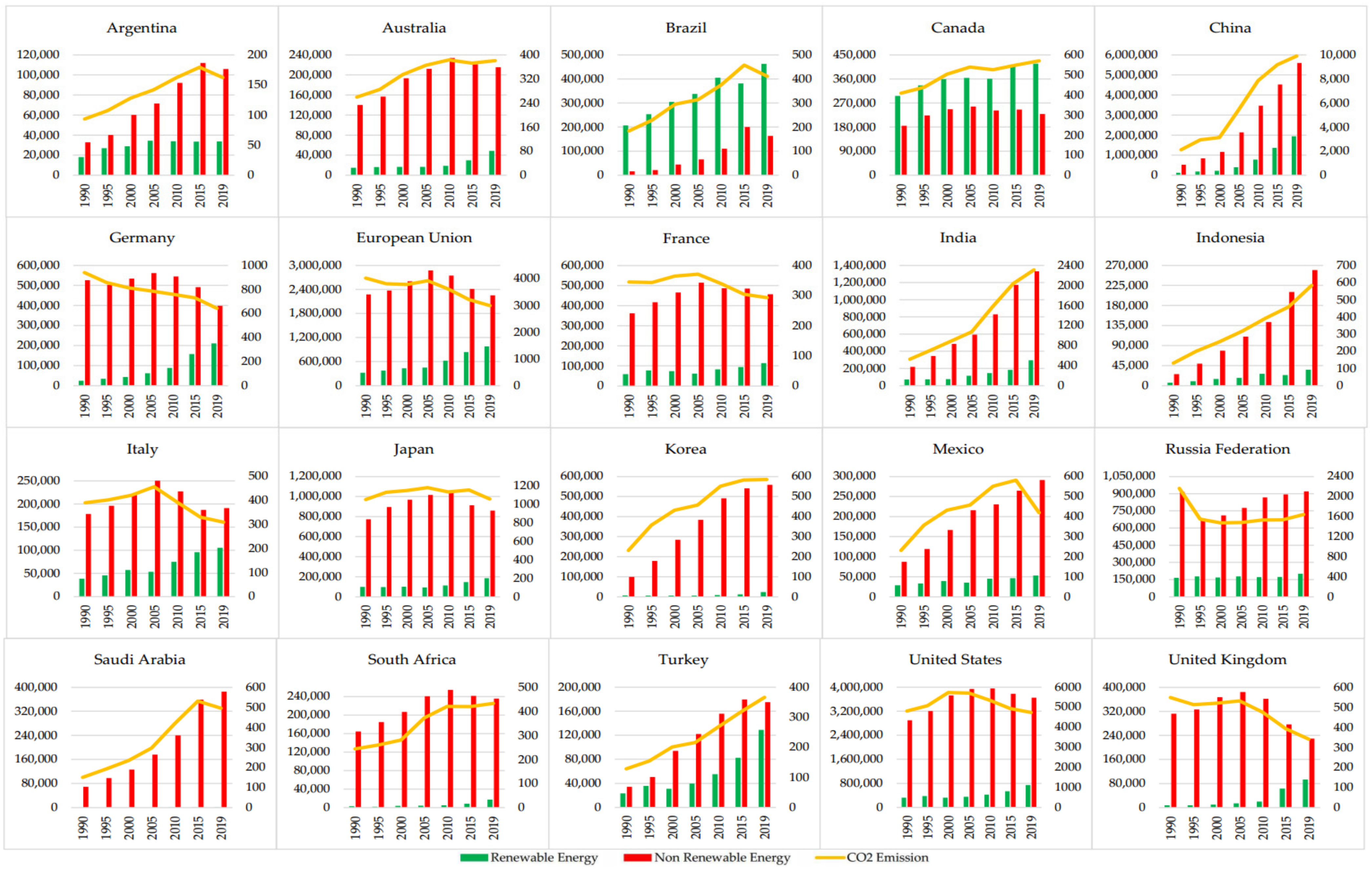
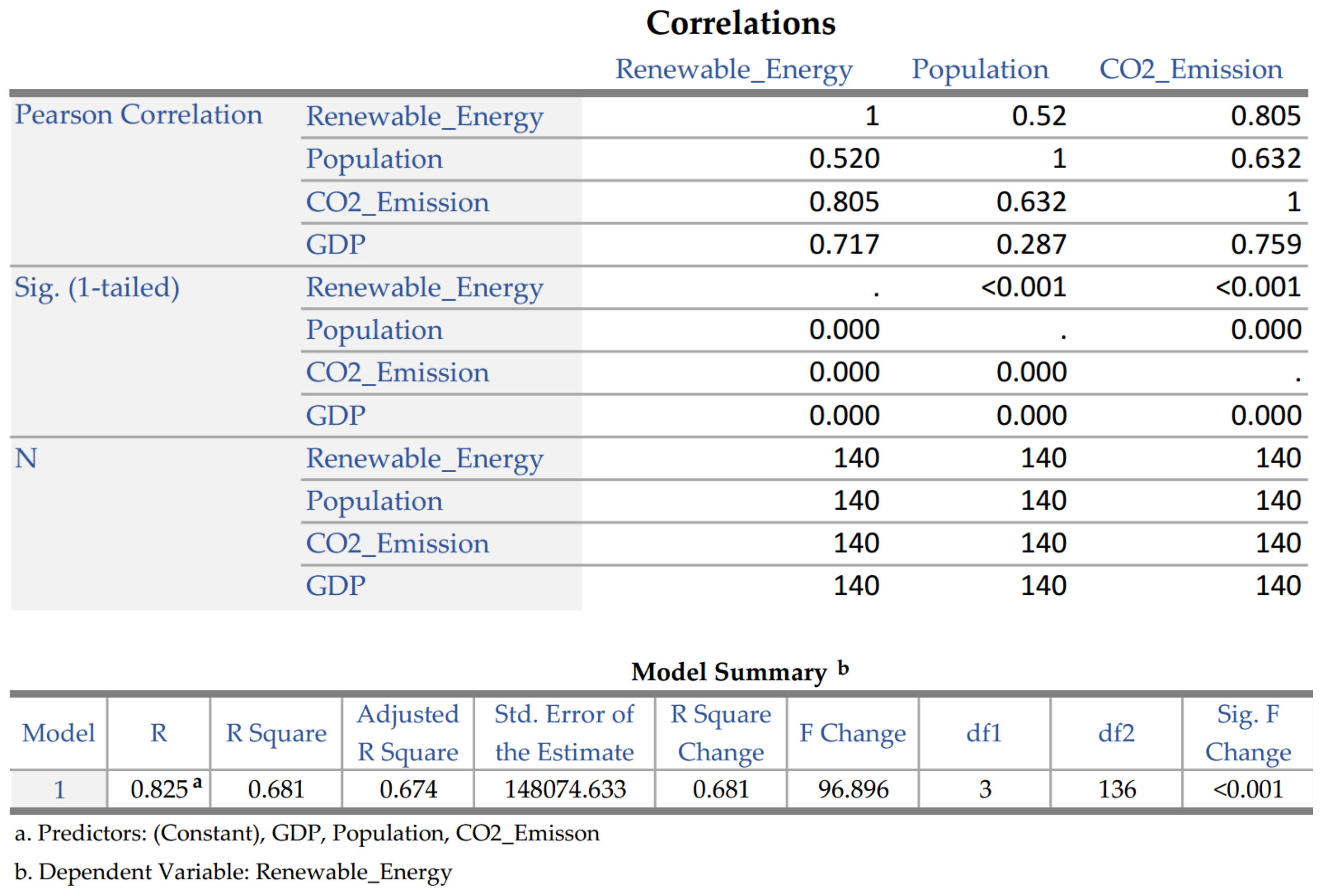


| Country | CO2 Emission (Mt) | CO2 Per Capita (Mt) |
|---|---|---|
| Canada | 571 | 0.0000152 |
| Australia | 380.7 | 0.000015 |
| United States | 4744.5 | 0.0000145 |
| Saudi Arabia | 495.2 | 0.0000144 |
| Russia Federation | 1640.3 | 0.0000114 |
| Korea | 585.7 | 0.0000113 |
| Japan | 1056.2 | 0.0000084 |
| Germany | 644.1 | 0.0000078 |
| South Africa | 433.6 | 0.0000074 |
| China | 9919.1 | 0.0000071 |
| European Union | 2993.5 | 0.0000067 |
| Italy | 309.3 | 0.0000052 |
| United Kingdom | 342.2 | 0.0000051 |
| Turkey | 366.4 | 0.0000044 |
| France | 293.9 | 0.0000044 |
| Argentina | 162.2 | 0.0000036 |
| Mexico | 419.4 | 0.0000033 |
| Indonesia | 583.4 | 0.0000022 |
| Brazil | 411 | 0.0000019 |
| India | 2310 | 0.0000017 |
| Country | GDP (Current US$) | % Renewable Sources in the Electrical Matrix |
|---|---|---|
| United States | 2.09 × 10¹³ | 19.10% |
| European Union | 1.53 × 10¹³ | 45.10% |
| China | 1.47 × 10¹³ | 28.00% |
| Japan | 5.06 × 10¹² | 19.50% |
| Germany | 3.85 × 10¹² | 37.60% |
| United Kingdom | 2.76 × 10¹² | 33.90% |
| India | 2.66 × 10¹² | 18.40% |
| France | 2.63 × 10¹² | 23.70% |
| Italy | 1.89 × 10¹² | 36.60% |
| Canada | 1.64 × 10¹² | 66.40% |
| Korea | 1.64 × 10¹² | 5.10% |
| Russia Federation | 1.48 × 10¹² | 20.30% |
| Brazil | 1.44 × 10¹² | 75.10% |
| Australia | 1.33 × 10¹² | 21.30% |
| Mexico | 1.07 × 10¹² | 18.80% |
| Indonesia | 1.06 × 10¹² | 12.30% |
| Turkey | 7.20 × 10¹¹ | 40.60% |
| Saudi Arabia | 7.00 × 10¹¹ | 0.10% |
| Argentina | 3.89 × 10¹¹ | 24.20% |
| South Africa | 3.35 × 10¹¹ | 6.90% |
Publisher’s Note: MDPI stays neutral with regard to jurisdictional claims in published maps and institutional affiliations. |
© 2022 by the authors. Licensee MDPI, Basel, Switzerland. This article is an open access article distributed under the terms and conditions of the Creative Commons Attribution (CC BY) license (https://creativecommons.org/licenses/by/4.0/).
Share and Cite
Sokulski, C.C.; Barros, M.V.; Salvador, R.; Broday, E.E.; de Francisco, A.C. Trends in Renewable Electricity Generation in the G20 Countries: An Analysis of the 1990–2020 Period. Sustainability 2022, 14, 2084. https://doi.org/10.3390/su14042084
Sokulski CC, Barros MV, Salvador R, Broday EE, de Francisco AC. Trends in Renewable Electricity Generation in the G20 Countries: An Analysis of the 1990–2020 Period. Sustainability. 2022; 14(4):2084. https://doi.org/10.3390/su14042084
Chicago/Turabian StyleSokulski, Carla Cristiane, Murillo Vetroni Barros, Rodrigo Salvador, Evandro Eduardo Broday, and Antonio Carlos de Francisco. 2022. "Trends in Renewable Electricity Generation in the G20 Countries: An Analysis of the 1990–2020 Period" Sustainability 14, no. 4: 2084. https://doi.org/10.3390/su14042084
APA StyleSokulski, C. C., Barros, M. V., Salvador, R., Broday, E. E., & de Francisco, A. C. (2022). Trends in Renewable Electricity Generation in the G20 Countries: An Analysis of the 1990–2020 Period. Sustainability, 14(4), 2084. https://doi.org/10.3390/su14042084








